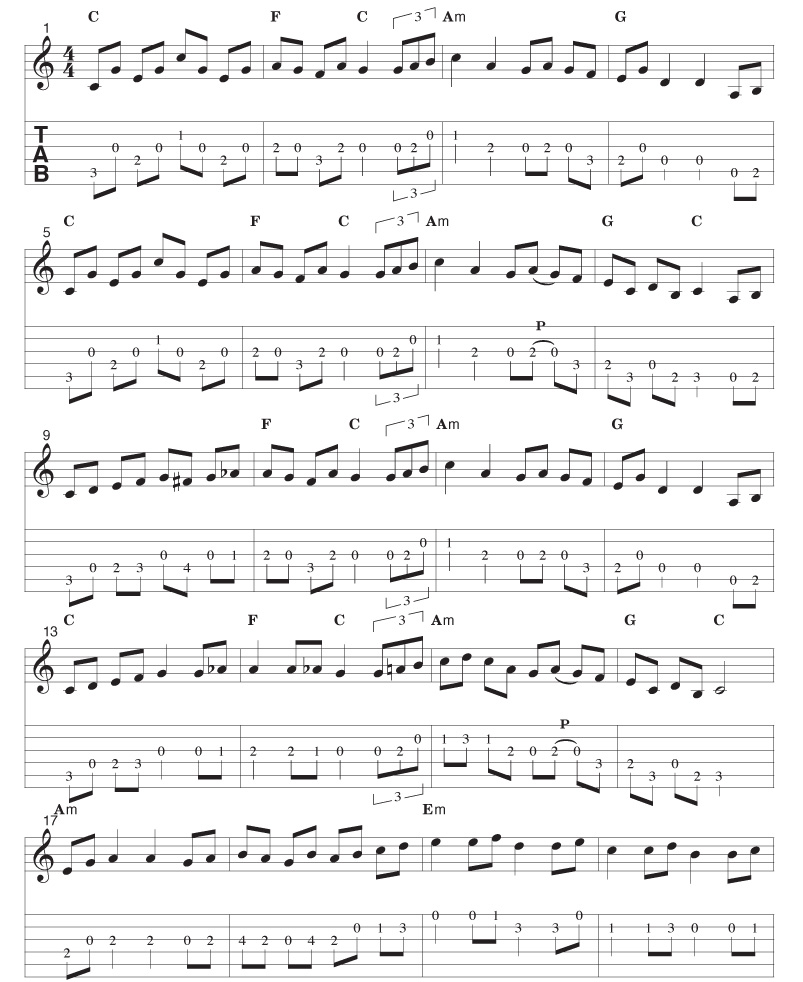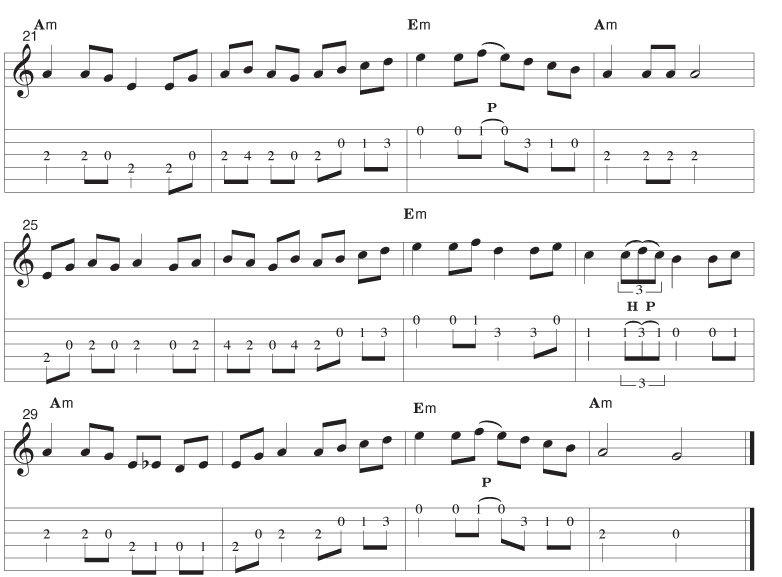Free Monthly Newsletter Lesson - August 2008Pick Stroke Theory Part II and The "Kiowa Special"by Mickey AbrahamDownload MP3 | Download PDF
Once again I’d like to thank all those who have emailed me with
positive feedback, questions, and lesson ideas. I take the time to read
and respond to every email I receive so please don’t hesitate to drop
me a line at [email protected].
This lesson is a direct follow up to last
month’s lesson “Pick Stroke Theory Part I.” In this part we will look at
how to treat hammer-ons, pulloffs, slides, and a couple basic triplets.
Let’s quickly recap our Pick Stroke Theory – on beats one, two, three,
and four we play all down-strokes and on all the “up beats” or “and”
beats we will be striking with an upstroke. This way, no matter what the
rhythmic pattern we are always moving our hand at the same tempo.
Take a look at the first example. This measure
would be played using All downstrokes. You see, the hammer-on is
“taking the place” of the actual “up” pick stroke. Next, you should
treat a pull-off the same way. The pulling off of the finger will be
“taking the place” of an actual pick stroke and will result in two
strokes in a row of the same direction. This is all keeping true of our
original pick stroke theory of down on down beats and up on up beats
(see example 2).
Example three incorporates sliding. You
should treat slides the same as hammer-ons and pulloffs. Although there
are two notes in this measure that fall on up beats, this measure would
also consist of four downstrokes! The slides end up taking the place of
what would normally be upstrokes.
Example 4 is revisiting a G-run, but this time
we are taking extra special care to make sure that we are, in fact,
keeping our pick direction correct. The run begins on an UP beat with
an UP stroke followed immediately by a slide and another up stroke.
Then, we encounter a down stroke followed immediately by a pull-off and
another down stroke. The slide has taken the place of the first
“downstroke” in the measure and the pull-off has taken the place of the
second up beat of the measure.
The next example is a bluegrass G lick that has
a little bit of everything. Try to apply the pick stroke theory
properly to this phrase. Look out for the slides, hammer-ons, and
pulloffs (see example 5).
Finally, I’d like to look at a couple common
fiddle tune style triplets. The first triplet example (example 6)
consists of two hammer-ons in a row. This would be played with two
downstrokes. The triple is being sounded with one pick stroke – that’s
three notes for one stroke!
The next triplet example is sounded by a
hammer-on with a down stroke followed by an up stroke on the next
skinnier string (see example 7).
I hope all this pick stroke theory is beginning
to make some sense to you. I’d like to put out there that are many ways
to pick the guitar and this is just one way that has worked well for
me. There are many variations of alternate picking that are also very
cool and useful like Irish triplets or sweep picking. These lessons are
just a place to begin to develop proper technique and good habits. Use
my ideas as stepping stones to invent your own useful picking
techniques.
I have also included a killer new tune for you to work on. The “Kiowa
Special” is one I picked up from dulcimer whiz Aaron O’ Rourke and it’s
one we recorded on our instrumental Trio CD. Let me know what you think
of this tune and remember to apply proper pick stroke theory to
everything you play.


|